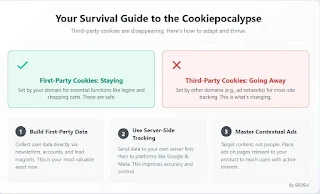The End of Third-Party Cookies: A Practical Guide to Prepare Your Website
First, What's Actually Changing?
Third-Party Cookies (Going Away): These are cookies set by a domain other than the one you are currently visiting. For example, when you visit mycoolblog.com, a cookie from facebook.com that tracks you for advertising is a third-party cookie.First-Party Cookies (Staying): These are cookies set by the domain you are visiting. They are used for essential functions like keeping you logged in, remembering items in your shopping cart, and basic site analytics.These are not going away.
How to Prepare Your Website: A 5-Step Action Plan
Step 1: Audit Your Current Cookie Usage
How to do it: Use Browser Developer Tools: In Chrome, right-click on your site, select "Inspect," go to the "Application" tab, and look under "Storage" > "Cookies." You'll see a list of all cookies and their domains. Any cookie from a domain that isn't yours is a third-party cookie.Check Your Scripts: Look at the code in your website's <head> section. Identify scripts from:Advertising Platforms: Meta Pixel, Google Ads Remarketing Tag, LinkedIn Insight Tag, etc.Analytics Tools: Hotjar, certain features of Google Analytics.Social Media Widgets: "Share on Facebook" buttons, embedded Twitter feeds.Embedded Content: YouTube videos, Vimeo players.
Your Goal: Create a list of all third-party services running on your site. This is your "at-risk" list.
Making it Real: First-Party vs. Third-Party Cookie Examples
What are First-Party Cookies? (The "Good" Cookies)
User Login Session: A cookie named session_id or user_token that keeps you logged in as you navigate the site.Shopping Cart Contents: A cookie like woocommerce_cart_hash that remembers what items you've added to your cart.User Preferences: A cookie such as language=en or dark_mode=true that remembers your viewing preferences for the site.
What are Third-Party Cookies? (The Cookies Being Phased Out)
Advertising & Retargeting: The Meta (Facebook) Pixel sets a cookie named _fbp to track users for ad campaigns. Google Ads sets cookies like _gcl_aw to measure ad conversions.Social Media Widgets: An embedded "Share on X/Twitter" button can place a cookie to track your visit.Third-Party Analytics: Tools like Hotjar might set a cookie (_hjIncludedInSample) to understand user behavior across different sites where Hotjar is installed.
How to See Cookies on Any Website: A 4-Step Guide
Mouse: Right-click anywhere on the page and select"Inspect" .Keyboard: Press Ctrl + Shift + I (on Windows) or Cmd + Option + I (on Mac).
Click on "Application" .On the left-hand menu, look for the "Storage" section. Under "Storage," click the dropdown arrow next to "Cookies" .Click on your website's domain name (e.g., https://www.yourwebsite.com).
If the Domain column matches your website's domain (e.g., .yourwebsite.com), it is aFIRST-PARTY cookie .If the Domain column shows a different domain (e.g., .doubleclick.net, .facebook.com, .bing.com), it is aTHIRD-PARTY cookie .
Step 2: Build and Prioritize Your First-Party Data Strategy
How to collect it: Email Newsletters: Offer a compelling reason to subscribe (exclusive content, discounts, industry insights).Lead Magnets: Provide valuable resources like e-books, webinars, or checklists in exchange for an email address.User Accounts & Logins: Encourage users to create accounts to save preferences, track orders, or access member-only content.Surveys & Quizzes: Engage your audience while collecting valuable preference and demographic data.
Your Goal: Create direct lines of communication with your audience that you control, reducing your reliance on third-party platforms.
Step 3: Implement Server-Side Tracking
How it works (Simplified): Old Way (Client-Side): Your website tells the user's browser to send data directly to Google, Facebook, etc. This is easily blocked by browsers and ad-blockers.New Way (Server-Side): Your website sends all data toyour own secure server first . Then,your server decides which information to forward to Google, Facebook, etc.
Why it's better: More Control & Privacy: You control what data is shared.Better Accuracy: It's not blocked by browsers in the same way, leading to more reliable data.Faster Website: It can reduce the amount of heavy JavaScript running in the user's browser.
How to get started: Use a tool likeGoogle Tag Manager (Server-Side Container) . While more technical to set up, it's the new standard for robust tracking.
Step 4: Leverage Google's Privacy Sandbox Alternatives
Key Technologies to Know: Topics API: Groups users into broad interest "topics" (e.g., "Fitness," "Cooking") without revealing their specific browsing history.Protected Audience API (formerly FLEDGE): Allows for retargeting campaigns without letting advertisers track users across the web.Attribution Reporting API: Measures ad conversions without using cross-site user-level tracking.
Your Action: Ensure your advertising partners (like Google Ads and other ad networks) are adopting these technologies. This is mostly about staying informed and asking your ad reps how they are preparing.
Step 5: Master Contextual Advertising
How it works: Place your ads on web pages that are relevant to your product. For example, if you sell hiking boots, you place ads on articles about "the best hiking trails" or "gear reviews for trekking."Why it's powerful: You are reaching users who are actively engaged with a relevant topic, making them highly receptive to your message. It's privacy-friendly and highly effective.Your Action: Explore advertising networks that have strong contextual targeting capabilities.
An Opportunity, Not a Crisis
Momenul Ahmad
Momenul is a digital strategist specializing in audience-first SEO, semantic copywriting, and cross-channel marketing psychology. He helps brands win relevance over reach.





